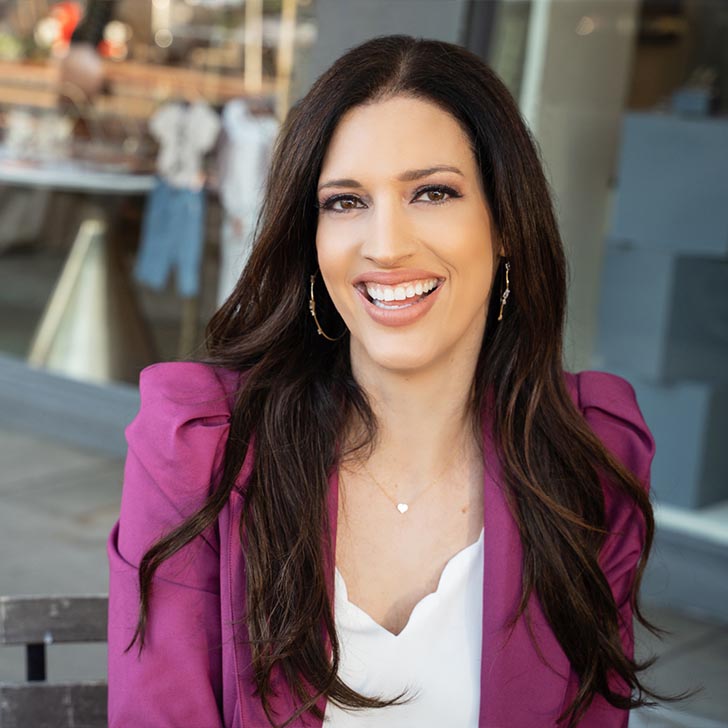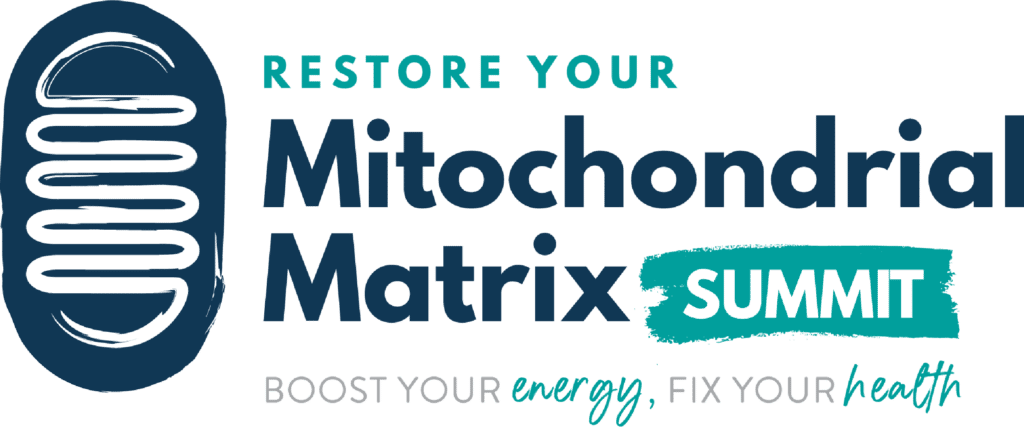Join the discussion below

Laura Frontiero, FNP-BC, has served thousands of patients as a Nurse Practitioner over the last 22 years. Her work in the health industry marries both traditional and functional medicine. Laura’s wellness programs help her high-performing clients boost energy, renew mental focus, feel great in their bodies, and be productive again.... Read More

Dr. Rodger Murphree is a chiropractic physician and board certified nutritional specialist. He is an internationally recognized fibromyalgia expert. His “Murphree Method,” a combination of functional and orthomolecular medicine, has helped thousands of patients get healthy and feel good again. He’s the author of 3 books for patients and doctors including... Read More
- Learn what fibromyalgia is, what causes it, who gets it and how to reverse the symptoms.
Laura Frontiero, FNP-BC
You’re watching the “Restore Your Mitochondrial Matrix Summit.” I’m your host, Laura Frontiero and I’m bringing you experts with fresh ideas and proven methods to help you boost your energy and fix your health, so you can build the life you love. And today my special guest is Dr. Rodger Murphree. Hi, Rodger. Welcome to the Summit.
Dr. Rodger Murphree
So glad to be here. This should be a lot of fun.
Laura Frontiero, FNP-BC
I know. I’m really excited to interview you. You are incredible with the work that you’ve done around Fibromyalgia. I wanna introduce you to the audience, then we’re gonna jump right in. Now, you’re a Board Certified Chiropractic Physician and a Board Certified Nutritional Specialist, and you are really internationally recognized as a Fibromyalgia expert. You have something called the Murphree Method. It’s a combination of functional and orthomolecular medicine. And you’ve helped thousands of patients get healthy and feel good again. You’ve authored three books about Fibromyalgia, Chronic Fatigue Syndrome, even a book about anxiety and depression and heart disease. So you are a man of many talents, and I know our audience is gonna be really excited to hear you talk about Fibromyalgia. But before we get into what is Fibromyalgia, can you tell me a little bit about your journey to this? Like, why Fibromyalgia? How did you get here? Why is this your specialty?
Dr. Rodger Murphree
Well, thanks, Laura. Well, we had a little bit of a conversation before we did the recording and kind of jokingly said, “Who would choose to be a Fibromyalgia Specialist?” You know most people would not and I say that with a lot of love and compassion. But it’s a very challenging illness certainly to have. But also as a physician to try and treat an illness that’s really kind of a medical misfit type illness, but. Years ago, I was happy just to be a Chiropractor and work on low back pain and sciatica and migraine headaches and carpal tunnel, that kind of thing. And I really enjoyed that, but I had patients who would ask me, “Dr. Murphree, you look so healthy. “What do you do? How do you take care of yourself?” And I’d just start sharing with them just the things that you and I do to stay healthy.
Diet, nutrition, exercise. And as I started sharing more and more of these tips, I saw that not only did their low back pain go away, but they looked better, they had more energy, they felt better. Got really interested in functional medicine 22 years ago. And I had a patient that came to me that had Fibromyalgia. I was known as kind of the Doctor that medical misfits went to, people who had been everywhere, kind of tried everything, or just were a little bit discouraged about conventional medicine, looking for something different. And Sheila came to me back in 1990, I guess. Goodness. A long time ago. No, 2000, 2000. I’m sorry. I knew that couldn’t be right. And she had Fibromyalgia. The doctor that had diagnosed her with it didn’t really know much about it, said, “Here’s muscle relaxers, some anti-inflammatories. “If you get desperate, here’s some pain medication “and I’ll see ya in six months.”
Well, I heard her history. She shared this long list, ’cause Fibromyalgia have a lot of different symptoms. And my first thought, Laura, was, “This is a hypochondriac.” Well, I wanna be nice, but how am I gonna break it to her that I can’t help you. You’ve got all this stuff going on. No way you could have all these different symptoms and still be alive. Well, but later, as we spent more time together in that interview, I realized she is telling me the truth. She has nothing to gain by making this up. I was able to get her well, reverse her Fibromyalgia in three months. And-
Laura Frontiero, FNP-BC
Three months?
Dr. Rodger Murphree
Now, I was gonna say before, those who have Fibromyalgia are going, “Yeah. Right. “Okay, let’s go to the next interview.” So I quickly learned that they weren’t all gonna be that simple. Sheila did really, really well. But as I started getting more and more referrals from the medical community here in Birmingham, Alabama, I realized I was in trouble. And so I set off on a mission to learn everything I could about functional medicine, orthomolecular medicine. Anything that I could steal, borrow from other practitioners that were having success with different portions of what was causing Fibro, I put into play. And that came about developing this thing called the Murphree Method and I wrote a book in 2003 on Fibromyalgia. And at that time there really wasn’t a whole lot being written about it, and it just kinda took off. I got invited to speak all over the United States and then even Overseas. And I never would’ve chosen it, but it is-
Laura Frontiero, FNP-BC
It chose you.
Dr. Rodger Murphree
It’s very rewarding though, to be able to help these folks that really desperately need help.
Laura Frontiero, FNP-BC
It chose you, Rodger. It chose you.
Dr. Rodger Murphree
Yeah. It chose me. Absolutely. Right. Right.
Laura Frontiero, FNP-BC
I just have to share with you. I worked in a traditional medicine for a big HMO for 20 years before I transitioned into functional medicine. And I can remember when I’d see on my daily schedule, a woman coming in and her one of her diagnoses was Fibromyalgia, I can remember just feeling like, “Oh gosh, “this is gonna be a long visit. “I’m not gonna be able to help this person.” And in looking back, it was very disempowering working in the traditional medicine model because we didn’t have solutions for people. And of course, there was that stigma that you have all these somatic complaints, it’s in your head. And a lot of times, they would come with a lot of traumas that were unresolved and relationship problems, and just this whole host of things. And I can remember feeling like I can’t help this person. And so, things have changed now all these years later after I learned functional medicine and we learn a lot more about the root cause of Fibromyalgia and how to resolve it. And thankfully, there’s people like you that are helping. And so now it’s not so terrible, right? When I get a Fibromyalgia patients like, “Oh! I know how to help you or I know somebody who can.” It’s not, you don’t feel- It’s this disempowerment. And I will say in a Western medicine model, that feeling of disempowerment is a really awful thing to feel when you can’t help people.
Dr. Rodger Murphree
Yes.
Laura Frontiero, FNP-BC
It really is. So let’s get into what it is and what causes it and who gets it and why. So can you give us kind of an overview? What is Fibromyalgia and-
Dr. Rodger Murphree
Yeah.
Laura Frontiero, FNP-BC
The whys of it.
Dr. Rodger Murphree
Yeah. So Fibromyalgia is a syndrome. So a syndrome is a group of symptoms that people have in common. People probably have heard Irritable Bowel Syndrome, which is a collection of symptoms of bloating and gas, stomach pain, loose bowel movements, constipation. With Fibromyalgia, the common symptoms are diffuse, achy, sometimes disabling pain, fatigue, exhaustion, brain fog, restless leg syndrome. Irritable bowel goes with Fibromyalgia. And the list can be rather long. It can be. Everybody’s Fibromyalgia is a little bit different than the next. But Fibromyalgia is just a name. Fibromyalgia doesn’t cause the pain or the low energy or the brain fog or the low moods, it’s just a name given to describe this condition. And it affects primarily women between the ages of 30 and 70.
Probably the biggest bulk of that is between 40 and 60. But 98% of those who have Fibromyalgia are women, and it’s estimated somewhere between eight and 10% of the world population has Fibromyalgia. It’s an illness that I believe is brought on by stress, which is nothing new, right? I mean, we would probably both agree that as most healthcare practitioners would say, that most conditions are brought on by stress and inflammation. Those are the triggers. But with Fibromyalgia, it really is a dysfunction in the mitochondria, a big part of that has to do with the body’s inability to regulate itself. So they have a dysfunction of the hypothalamus, pituitary, adrenals, the self-regulating mechanisms that help control the different systems of the body.
But when it gets under too much stress, it starts to have problems and those problems show up as symptoms. For Fibromyalgia, usually the first symptom is poor sleep or pain. They can go hand in hand, but once someone starts to experience poor sleep on a consistent basis, and you know this as a practitioner, they really start to run the risk of having all sorts of health problems. But Fibromyalgia is a syndrome, is caused by, I really believe, stress is the catalyst for it. And the people most likely to get it are Type A’s. So right? What you see in your practice.
These are the doers, right? They’re working 40 hours a week at one point. A lot of these people are on disability now, but they’re working 40 hours a week, probably on the PTA Board, they’re a volunteer at their church, they come home, they maybe have to cook dinner or shuffling their kids around to all the different functions they have. But so they do and they do, and they do, and they do, and they do, and then one day they’re just done out and that’s it and their health starts to suffer. And then eventually, after going to half a dozen doctors or more, and over a period of four or five years, they finally get the diagnosis of Fibromyalgia. So, but there is hope. There’s things that can definitely be done to reverse all that.
Laura Frontiero, FNP-BC
Yeah. So talk to us a little bit about is there anything else besides stress that causes it? Have you noticed anything else, any other similarities or commonalities between the patients that you’ve worked with and what they have? And can you talk a little bit about your Murphree Method maybe? Or your Jumpstart Protocols and what do you do? So now you’ve identified it, they finally got a diagnosis, where do people go from here?
Dr. Rodger Murphree
So one of the common denominators for these folks is that they have less mitochondria than the average person. Just genetically, the way God made them, for whatever reason, they don’t have as many mitochondria. They also have a lot of dysfunction. So a lot of their mitochondria are dysfunctional and not working like they’re supposed to. Now that’s brought on by stress, some of that’s brought on by stress, oxidative damage, poor diet, sedentary lifestyle, nutritional deficiencies, which are common in most chronic illnesses. But in particular with Fibromyalgia, one of the big common denominators is, as I mentioned, stress. But we could substitute stress for another name, trauma.
So these individuals oftentimes came from very traumatic household, a lot of stress. So it could be abuse. Unfortunately, it could be verbal or physical abuse. But it could be a very toxic household that they grew up in that was just a very stressful environment to be in. Or it could be that they were in a military family and they moved a lot, and just those teenage years were really stressful because of that. But they lose their plasticity, their ability to rebound, to bounce back from stress. And so as they go from a very toxic childhood oftentimes, then they get into maybe their college years or first years of marriage or first years of their work, their career and it’s just this additional stress, that most of us are able to navigate, for these individuals, this stress comes on and they may be able to navigate that for a while, but then maybe they have a hysterectomy or maybe they have loss of a loved one, or maybe have a special needs child that they’re taking care of, but eventually there’s a straw that breaks the camel’s back and that’s it for them. And once they fall apart, there’s no drug that can put them back together, unfortunately. So it’s a process of looking at where they’re broken down and fixing those things so that the body can then do what it’s supposed to do, which is to self-regulate itself.
Laura Frontiero, FNP-BC
Yeah. So how do you even start figuring out what’s broken down? What do you do? Are you doing functional labs? Are you doing a lifestyle and health history intake? Are you doing physical exam? What is it that kinda helps you figure and pinpoint this?
Dr. Rodger Murphree
Well, my practice is all telehealth at this point. Like a lot of us, I’ve moved to telemedicine. But a lot of functional testing because you can guess, you can try to guess and try to figure it out, but with a complex illness like Fibromyalgia, most of these individuals have tried all sorts of different diets and supplements and, of course, medications. Oftentimes, when I start working with a patient they’re on half a dozen or a dozen drugs, which don’t work. But what I have found are there some key denominators that if you can get these right, it will set them up to be able to have success even though it’s kinda like an onion. You gotta peel these different layers, you know? So you have these layers of dysfunction that you have to peel away.
And it may take a while, but in the Jumpstart Protocols that I developed years ago, the first step is deep restorative sleep. And that sounds, well, I mean, who needs sleep? I’m a Type A. I pride myself in not needing a lot of sleep. Well, you can do that for a while, but now when you develop a chronic illness and I don’t care whether it’s Fibromyalgia or Rheumatoid or Sjogren’s or whatever it is that’s giving you trouble, if you’re not getting deep Delta wave sleep, this deep restorative sleep, you’re gonna be at risk of developing all the symptoms that we would see in Fibromyalgia. ‘Cause we know if you’re not getting deep restorative sleep, you increase your inflammatory chemicals by 40%. Now that’s dramatic, but if you realize as you and I know that everybody, just about everybody’s, walking around with some type of inflammation already. If you’re carrying around extra weight, you got inflammatory chemicals that are being generated in those fat cells. But if you’re not getting deep restorative sleep, what we see is that your pain threshold goes down so now pain is magnified, it’s more intense than it should be.
If you’re not getting deep restorative sleep on a consistent basis, obviously, eventually you’re gonna be exhausted so that’s what we see in Fibromyalgia. You’re gonna have mental clarity issues. So we see Fibro Fog. If you’re exhausted, you’re gonna be irritable, probably, probably gonna be anxious. You got this nervous stress that just takes over. Probably gonna have low moods. You’re at risk for getting Irritable Bowel Syndrome. And I use this analogy that we’re all born with a stress coping savings account and as we go through life, we’re using these chemicals all day long to be able to deal with the stress that we’re under. So in that account we have things like, well, like serotonin, the brain chemical that is the happy hormone. It reduces anxiety, it helps with depression. But also, your serotonin level helps to raise your pain threshold. I’m sorry.
So you have less pain. You have more serotonin receptors in your intestinal tract than you do in your brain, so when you get nervous, you get butterflies in your stomach, not your head. So once we can get someone going in a deep restorative sleep, they start to make deposits into their stress coping savings account. So we see that a lot of the symptoms with Fibromyalgia are dramatically improved. If they’re getting a good night’s sleep, they’re gonna have higher pain threshold, less pain. Doesn’t matter where that pain’s coming from, whether it’s coming from osteoarthritis, osteoporosis, scar tissue, whatever, raising that pain threshold is gonna lower that pain. They’re gonna have more energy. Obviously they’re getting a good night’s sleep. They’re gonna think better. So that Fibro Fog is gonna improve. Irritable bowel starts to improve. So the first step, and I think you’ve gotta get that right, if you don’t, you’re really fighting an uphill battle, but it’s deep restorative sleep.
Laura Frontiero, FNP-BC
Let’s talk about that deep restorative sleep for a minute, because I know even in my own practice with my own clients, it’s kinda like it’s sometimes really hard to get people to prioritize sleep. It’s the simplest thing, yet it’s the hardest thing for people. They just don’t stick to a routine of slowing down at night, thinking about getting ready for bed, getting in bed by nine, 9:30, and giving them a really long, spacious, beautiful sleep. They’re pushing, pushing, pushing, finally dropping in bed at midnight, no matter what. And then there’s the people who say, “Okay, Doc, but I try to go to sleep “and I lay there awake and I’m not getting sleep. “Or I wake up all night long.” So sometimes deep restorative sleep is easier said than done and people give up. So what do you do? Kinda help people troubleshoot some of those things, ’cause if that is the biggest answer to Fibromyalgia, I know you’ve gotta spend a lot of time troubleshooting this with people.
Dr. Rodger Murphree
Well, it’s the biggest first step without a doubt. Because I’ve worked with practitioners all over who ask me, “What do I do with these people?” And I tell them, “If you don’t get this right, “I don’t care what you do, you’re not gonna have success.” And the reason why is, is because if, as I mentioned, if you’re not getting that sleep, you continue to bankrupt these chemicals that you need to work correctly. You’re so correct. These are the hardcore insomniacs.
Laura Frontiero, FNP-BC
Yeah.
Dr. Rodger Murphree
So if you wonder, people wonder, “Do I have Fibromyalgia?” ‘Cause it takes oftentimes half a dozen years and a half a dozen doctors for you to ever get the diagnosis. If you are able to fall asleep and sleep through the night, you don’t have Fibromyalgia. But if you’re someone who really struggles to fall asleep or you’re someone that wakes up in middle of the night and you can’t go back to sleep, if that continues, you’re at risk of developing Fibromyalgia, I really believe that. But where do I start for sleep? So a lot of people will look at melatonin, the sleep hormone melatonin, but you bypass, I think, the most important thing for getting Fibromyalgia under control and that is raising that pain threshold. Because they have this, as you know, a condition called Allodynia, low pain threshold, and Hyperalgesia where their nervous system is over-reactive and pain’s magnified. I start people on 5-hydroxytryptophan.
So 5-HTP, it’s an over-the-counter supplement. It’s an amino acid that you should be getting in your diet when you eat a protein food, it’s made up of these amino acids. And these amino acids, when they’re combined with B vitamins, magnesium and vitamin C, they turn into different hormones and different chemicals. In the case of serotonin, this brain chemical, 5-HTP, when it’s combined with these B vitamins and magnesium and vitamin C, that’s what makes serotonin. No one has a Prozac deficiency. You might have a 5-HT deficiency. And we know that genetically a lot of times that just the way, again, the way God makes these individuals, they can’t take this tryptophan that’s in the protein food they’re eating, turn it into 5-hydroxytryptophan, which turns into serotonin. They have a glitch that doesn’t allow that to happen. But I start them on 5-HTP, 30 minutes before bed, 100 milligrams of 5-HTP, 30 minutes before bed, with just a little bit of grape juice, about an ounce of grape juice mixed with water, that helps it. Insulin’s released and it helps to get that 5-HTP past the blood brain barrier. But 5-HTP increases your melatonin, your sleep hormone, by 200%.
Laura Frontiero, FNP-BC
Wow.
Dr. Rodger Murphree
And if you’re making the serotonin, now you’re making deposits of serotonin into your stress coping savings account so you’re gonna raise your pain threshold so pain goes down. Mentally, you have more mental clarity, less anxiety, less depressed. As I mentioned earlier, you have more serotonin receptors in your intestinal tract so serotonin controls the movement, motility, gut motility, your bowel movements. And once you start to raise that serotonin, oftentimes you see irritable bowels markedly improved. So my protocol is 5-HTP with a good multivitamin. But the 5-HTP, 100 milligrams, 30 minutes before bed. If you don’t fall asleep within 30 minutes, next night, you go to 200 milligrams. If you don’t fall asleep, next night, you go to 300 milligrams. If you’re still not falling asleep, now you start adding sublingual melatonin to that equation. But I try to do it all naturally, ’cause as you know, sleep medications have all sorts of side effects. And not to scare anybody, but we know from research out of Wake Forest and other places that taking sleep medication increases your risk of death by all causes by 500%. Again, not to scare anybody. I mean, there’s a time and a place. But now if that’s you and you’re on a sleep medication now, now you should start looking for some natural options, right?
Laura Frontiero, FNP-BC
Right. I really appreciate you being so transparent about what you do to help people. People are coming here looking for answers and support, and this is really, really helpful. And look, you’ve already helped somebody sleep without a prescription medication. That’s incredible.
Dr. Rodger Murphree
Yeah, I mean, I see people just getting them sleeping through the night is a total game changer, life changer for these individuals.
Laura Frontiero, FNP-BC
I know it’s criminal that Western medicine isn’t recommending this. But the truth of the matter is there’s no money in 5-HTP. It’s not something that a pharmaceutical can patent and market as a sleeping medication. It’s just a natural amino acid. I mean, it’s- And so since there’s no money in it, it’s not used in the Western medicine world.
Dr. Rodger Murphree
Right.
Laura Frontiero, FNP-BC
Really sad.
Dr. Rodger Murphree
Unfortunate, but true. Yeah, yeah.
Laura Frontiero, FNP-BC
Yeah. Well, okay. So sleep, what’s your next part of your Jumpstart Protocol?
Dr. Rodger Murphree
So once- And this happens really all at once, but what I learned early on, Laura, was, okay, if I get them ’cause it just makes sense, right? You really think about it. I mean, when you have an illness, really, ideally you wanna think about, “Well, why do I have pain? “Why do I have low energy? “Why do I can’t use the bathroom?” I mean, but most people don’t think that way. They think, “Oh, I need to go to the doctor “and get a drug,” or whatever it is. But if you think about it, it makes sense, right? I mean, if you get a good night’s sleep, a lot of those symptoms are gonna improve.
Well, what I found though early on when I just was focused on that, these individuals who hadn’t slept in a decade, not well, they started sleeping through the night, they felt better than they felt in years. And then they would go do things that they hadn’t been able to do in years. So they’d go shopping for the first time in a decade, they would try to go meet friends out for lunch or dinner or socialize, whatever it is, because they finally felt decent. And then they’d crash. They would crash for three, four, five days. They have a thing called a Fibro Flare. And what I realized was not only did they have problems with insomnia that were really sabotaging them, and then they bankrupted their stress coping savings account, they had bankrupted their stress coping glands, the adrenal glands. And so what happens with these individuals is because they have no stress coping chemicals, at least initially, they start to build those up a little bit, but they have lost their stamina and resilience to stress so stress becomes magnified.
Laura Frontiero, FNP-BC
Yeah.
Dr. Rodger Murphree
Little things that we would take for granted, like changes in the weather, bright lights, loud noises, being in a car and traveling in a car, you know there’s things that we don’t even think anything about. For these individuals, this is magnified a thousand fold. So what I realized is, okay, well, we gotta fix the adrenals then. So we get them on adrenal fatigue protocols where they can start to repair those adrenal glands. Then now they have more stamina. They can get to where they can do more and not crash. So that’s part two of the jumpstart protocols. Part three, this is something that you really do so well and that’s focusing on GI conditions. Because we’re all told you are what you eat and we get jaded to that. But the truth is we are what we eat. I mean, the way we look. Do we look healthy? Is our skin healthy and our hair? But eating healthy long-term creates health. It is. It’s a fact.
But what we miss oftentimes is it’s not only eating healthy, but it’s being able to absorb those foods and utilize the nutrients that are in those foods. So what we see with Fibromyalgia is that notoriously, they have problems with digesting and assimilating these nutrients. So they have GERD and reflux and they have small intestinal bacterial overgrowth is a biggie, leaky gut, something I know you talk quite a bit about. Food allergies is a common. Everyone has food allergies of some sort, but they have these digestive and elimination problems that are preventing them from hanging on and utilizing the nutrients that they need to really make the hormones and to make the chemicals that the body needs to be healthy. So we wanna look at finding and fixing any of these underlying GI disorders. And the place I usually just start is a digestive enzyme. It’s simple, it’s inexpensive. A lot of times just doing that can make a big difference. Now, it’s not gonna get rid of leaky gut, but it can make a dramatic difference in the bloating and the gas and the problems that these individuals experience. So that’s three. And this, okay, even though I’m rambling here.
Laura Frontiero, FNP-BC
No, it’s perfect. So let’s just recap. You’ve got fix the sleep, fix the adrenals, which I’m assuming that these people can’t even launch cortisol, like their cortisols are just flat-lined probably. When you-
Dr. Rodger Murphree
They usually are. So if you do a functional medicine test, like I did, and I’m sure you do, you can do a fasting, early morning cortisol test, but that’s inconvenient. But a saliva test where you see a four sample, you see, normally you’ll see that it’s bottomed out in the morning and then kind of flat-lines, you know?
Laura Frontiero, FNP-BC
Yeah.
Dr. Rodger Murphree
And I’m sure you see this too in your practice, a lot of times though I’ll see first thing in the morning, it’s really high.
Laura Frontiero, FNP-BC
Yeah.
Dr. Rodger Murphree
That’s ’cause they’re not sleeping, the stress of not sleeping, and the anxiety, this anxiety they have. But then it’s high, but then it just crashes.
Laura Frontiero, FNP-BC
Yeah.
Dr. Rodger Murphree
And that’s a problem. Or it’s low in the morning and then about eight o’clock, nine o’clock, they get that second wind. These are the night owls, right?
Laura Frontiero, FNP-BC
Yeah.
Dr. Rodger Murphree
And it goes up and then that spike in cortisol sabotages your melatonin level so you can’t sleep. So there’s different patterns to this, but adrenal fatigue is, I would say, 95% of the people that I work with over the last 22 years have adrenal fatigue.
Laura Frontiero, FNP-BC
I’m glad we talked about this, ’cause I think it’s really important for people to know. Fixing your adrenals isn’t something that you just go look on Google and figure out. You really gotta test and see are you the type that doesn’t launch cortisol at all, any time of day? Is it high in the morning, low the rest of the day? Is it low in the morning, high in the evening? I mean, there’s so many different variations of this so it’s really important to work with somebody like Rodger or myself to figure out what’s happening with your adrenals. So first is sleep, second, adrenals. Third thing is gut health. So that’s where we’re at so far, right?
Dr. Rodger Murphree
Yeah.
Laura Frontiero, FNP-BC
Fix digestion.
Dr. Rodger Murphree
And number four is I really believe this and I learned this, I used to have a integrative medical practice on the campus of Brookwood Hospital here in Birmingham, Alabama. And we did intravenous IV therapy, so Myers’ Cocktail before it ever became a thing. This is back in 2002, 2003, whenever. And we would give people these high doses of vitamins and minerals and vitamin C and sometimes glutathione. And by doing that, we could see dramatic improvement in Fibromyalgia symptoms. But it wasn’t practical. We had people coming from all over the Southeast and they couldn’t drive in or fly in. People flew too. But we couldn’t have people traveling to see us every week to get an IV. And it was inconvenient, it was costly, you had to sit there for three hours and get this thing. So I learned through testing and spectra cell, some of those other things testing about these common deficiencies.
And I found out the only way really to shore that up was for these individuals to take high doses. And that’s orthomolecular medicine, high doses of vitamins, minerals, amino acids and essential fatty acids to overcome their cellular resistance, what they needed. ‘Cause people look at the RDA. What is the RDA? The RDA is the Recommended Dietary Allowance. I call it the Recommended Disease Allowance. If you go by the RDA, Centrum Silver, One A Day, these kind of things, it’s enough to keep you from getting beri-beri or scurvy, but it isn’t gonna reverse a complicated illness, a biochemical illness like Fibromyalgia. So by using these high doses, safe doses, but this is what I call the optimal daily allowance, Laura, which is like I recommend they taken, 200 milligrams of thiamine, which I think the RDA is 3.2 milligrams. So you can see it’s a big difference. But we are as different on the inside as we are on the outside. And for what one person can take, I recommend typically about 600, 700 milligrams of magnesium, which is a natural muscle relaxer for these individuals, and helps with the mitochondria. Big, big part of the mitochondria effect. But some people can do that and they’re fine. Other people, they take 100 milligrams of magnesium, they’re in the bathroom all day.
Laura Frontiero, FNP-BC
Yeah.
Dr. Rodger Murphree
So we’re different. We’re different. And the way you get around that is by looking at optimal daily allowances, which are much higher doses, to really change that biochemistry so that the physiology can have the chemicals that it needs to work correctly.
Laura Frontiero, FNP-BC
Yeah. It’s something really important, a really important concept that you’re sharing here that I just wanna say in another way for people so they really get it. Is we all hear, “Let food be thy medicine,” but in this type of situation, when you have a chronic syndrome or a chronic disease, you’re not gonna eat your way out of it. You need higher levels of nutrients to kind of get over that hump, over that mountain, reduce the inflammation, heal up the gut microbiome, fix the mitochondria functioning, and then simmer down this syndrome or whatever chronic disease you have, and then once you get to that point, let food be thy medicine for the rest of your life, right?
Dr. Rodger Murphree
Yeah.
Laura Frontiero, FNP-BC
Yeah.
Dr. Rodger Murphree
You know, I really believe you can. So Fibromyalgia, can you overcome it? Absolutely. The only way to do it is you gotta get healthy. And that sounds so simplistic, I know, but it’s not because where do you start? So many things are broken down. That’s why doctors have kind of given up, as you mentioned. Most Rheumatologists won’t even take Fibromyalgia patients anymore.
Laura Frontiero, FNP-BC
Yeah.
Dr. Rodger Murphree
And when I talk to colleagues who, in functional medicine, integrative medicine, whatever, or even in conventional medicine, they’ll tell me, “Rodger, when I see them on my schedule, “I’m already just thinking this is gonna be a bad day.” And it’s not that they’re not empathetic, it’s not that they don’t care, they do. It’s just that they don’t know what to do with them.
Laura Frontiero, FNP-BC
No.
Dr. Rodger Murphree
So they feel helpless. Which as you said, is a terrible feeling as a healthcare professional. You feel so lost. But the only way to overcome this thing is to get healthy and you can’t get healthy unless you eat healthy. But diet is the long game.
Laura Frontiero, FNP-BC
Yeah.
Dr. Rodger Murphree
That’s the long game. You can’t turn this thing around in three to six months just changing your diet, but you have to change your diet to be able to keep those results long-term, even using the Jumpstart Protocols and the Murphree Method, diet is a big part of that.
Laura Frontiero, FNP-BC
Oh yeah. Foundationally, it must be done.
Dr. Rodger Murphree
Yeah.
Laura Frontiero, FNP-BC
And you wanna take a slow road or do you want the fast pass? So the fast pass is change your diet and take these nutrients to optimize.
Dr. Rodger Murphree
Right, right.
Laura Frontiero, FNP-BC
Right? You know, something that’s coming up for me as we talk about this is Western medicine, rheumatology, primary care, internal medicine, they are never going to have a solution because there is no big money for medicine in helping people sleep, eat healthy, and fix their gut. I mean, we’re talking supplements, we’re talking food, we’re not prescribing drugs for this. And so I think people just really can’t look to their Western medicine practitioners to support this. I mean, do you know of any successful Fibromyalgia clinics that are funded by insurance that actually work?
Dr. Rodger Murphree
No. And you know what has happened, it’s a very tainted environment now because what’s happened is physicians in conventional medicine, they were told, “Well, we got Neurotin and we got Gabapentin and Lyrica “and Savella and Cymbalta “and these things have been approved for Fibromyalgia.” They wanna be helpful, so they’re recommending these different things. They’re treating the symptoms, that’s what- And there’s a time and a place for that. But with Fibromyalgia, there’s so many symptoms that if you’re not careful, you’re on a drug to put you asleep, drug to wake you up, a drug to speed you up, drug to slow you down. I mean, you’re on half a dozen to a dozen drugs. And what these practitioners have seen over time is that these medications don’t reduce Fibromyalgia symptoms, maybe short-term. And long-term, they create more problems. So now what you hear is, “You just have to learn to live with it.”
Laura Frontiero, FNP-BC
Yeah.
Dr. Rodger Murphree
Which is a terrible thing to hear if you’re thinking that, “I’m gonna have to live in chronic pain, have no energy. “I’ve lost my livelihood. “I maybe have lost my marriage. “No one understands what I’m going through. “I have no friends, I can’t do anything.” And they tell you just to learn to live with it. Well, that’s not living, that’s just existing. That’s a terrible state to be in.
Laura Frontiero, FNP-BC
It is. It is. Well, thankfully there’s people like you who are creating these programs. So anything else on the Jumpstart Protocol before we talk a little bit more about mitochondria and how someone reduces or eliminates their Fibromyalgia symptoms further?
Dr. Rodger Murphree
Well, so the Jumpstart Protocols, those four key things, these are like the legs of a table. If you move- If you don’t get one planted, then that table’s unstable. You might be able to do it with three and you feel like you’re doing okay, get down to two, you’re in trouble. One, just not even, you know? But that lays the foundation, as you mentioned earlier. But I find there’s more to that. You can dramatically reduce your symptoms just with those four things. But 70% of the patients I work with have a problem in their thyroid. Never been diagnosed or is not being treated properly. I see a lot of those folks. I see a lot of my patients have problems with food allergies. We know that’s a common driver of inflammation for a lot of these folks.
So there’s different things, again, peeling away the onion that have to happen. As far as the mitochondria, which is obviously this whole Summit is about. Because they have less mitochondria and because their mitochondria are dysfunctional, many of them are, we need to provide them with key nutraceuticals that will help that like malic acid, CoQ10, just B vitamins, antioxidants to help to reduce that oxidative stress which is creating free radical damage and generating all this inflammation that we see in these individuals. Changes to their diet, just eating foods that will help boost glutathione production. These things that we know are crucial to helping the mitochondria and helping the body work like it’s supposed to.
Laura Frontiero, FNP-BC
Oh yeah. Your Jumpstart Protocol is a mitochondria protocol too.
Dr. Rodger Murphree
Yeah.
Laura Frontiero, FNP-BC
I mean, it’s literally the same things that we do to support mitochondrial health. And it was just another testament to we are interconnected, every system in our body is interconnected. And it comes back to that really microscopic cellular level work. And once you give your body what it needs, it can do miraculous things.
Dr. Rodger Murphree
Yeah. Yeah. I think that’s what saved me, by the way. So my background being a Chiropractor, we have a background that’s very holistic. It’s all about, the power that made the body can heal the body, if it gives the right environment and the right things. And coming from that paradigm, I think really saved me because even when I had these patients that were flooding. Now, I was flooded when the word got out that I was helping these people with Fibromyalgia because no one knew what to do with them.
Laura Frontiero, FNP-BC
Yeah.
Dr. Rodger Murphree
And so I was flooded with them. And what saved me, Laura, was realizing if I can just get some key things working, this innate inborn healing system that we have in us can do its job. We don’t have to think about taking 12 breaths per minute, we don’t have to think about digesting our food or mending broken bones, or any of the things that the body’s so capable of doing. But sometimes it needs some help. And fortunately, I was able to realize that, okay, if I can just understand that and buy into that philosophy, that helped me not be so intimidated by so many complicated patients.
Laura Frontiero, FNP-BC
Yeah. And those chipping away at those things, and people start to get better, better, better, better. Well, anything else before we wrap up today? This has been so good and I know you’ve given so many people hope with your strategies that have worked over and over and over again. Anything else you wanna share with people on tips? And then I want you to tell people where they can find you, how they can get ahold of you. How can they work with your protocols?
Dr. Rodger Murphree
Well, I would say this in wrapping up. I would say if you’ve been told you have Fibromyalgia and that you just need to learn to live with it, don’t buy into that. So if you’re willing to be proactive, ’cause there is some work involved. Like any chronic illness, there’s some work involved to overcome that. But you can get your life back, whether you go into full remission as many of my patients do, or you increase your vitality, you reduce your symptoms by 70% on average. That’s a success. Don’t let anybody tell you that you just have to learn with Fibromyalgia because that’s not true. Yes, unfortunately there’s not a lot of us out there that really understand Fibromyalgia and have any success, but there are those of us and you just need to find somebody that you can work with that you like and don’t give up. Just don’t lose hope.
Laura Frontiero, FNP-BC
Yeah. That’s such a message of hope too. How can we get a hold of you? How can-
Dr. Rodger Murphree
Yeah. Thank you. So there’s all sorts of free resources, a podcast, blogs, videos at yourfibrodoctor.com.
Laura Frontiero, FNP-BC
Amazing. Amazing. Thank you so much, Rodger. This has been so inspiring and incredible and I’m so glad for the work that you do and giving people hope with Fibromyalgia. Certainly it would’ve been nice to have it when I was in the traditional medicine world all those years. And it’s really a relief to know that there is hope that people can heal.
Dr. Rodger Murphree
Well, thank you so much for allowing me to be on here. I just love the opportunity to spend time with you and share this message with the Summit. And I look forward to all the interviews too, ’cause I know some of the people that you’ve got on here. It’s gonna be a fabulous Summit.
Laura Frontiero, FNP-BC
It is. It is. Thank you so much, Rodger. You take good care now. Bye.
Downloads










